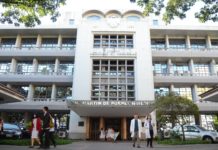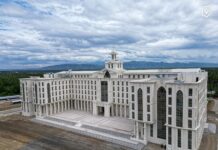IN 2004, the UST Hospital (USTH) was in the middle of what was a seemingly insurmountable crisis. Financial woes, including an astounding P62 million debt, hounded the hospital, almost crippling its ability to spend for its operations and upgrade its equipment.
While other medical institutions began to redevelop and keep up with the times at the start of the new millennium, USTH found itself stuck in a financial quicksand. Its performance and revenues slowly sank, due largely to internal and financial problems. Countless controversies regarding its equipment as well as accusations of tax evasion also added to its already mounting headaches.
Today, instead of drowning itself with debts, the hospital has risen from its “deathbed” as it has lured in more patients by upgrading its medical equipment and widening its range of services and specialization, and has even established an institute that specifically focuses on detecting and treating one of the most leading causes of death— cancer.
Road to recovery
An imbalance between the hospital’s two divisions, the private (pay), which is for more financially stable patients, and the clinical (charity), where rates and services are less expensive, is blamed to be the major problem of the hospital in the past. In 2004, there were over 400 charity beds in USTH, 42 more than the “pay” beds, which lessened the hospital’s patient service revenues. Today, the clinical division has 348 service beds plus 14 bassinets, while the private division has 352.
But despite this, the new USTH administration, composed primarily of doctors, was keen on putting the hospital back on track.
In Sept. 2004, the USTH was declared a separate entity from Medicine through a resolution by the UST Board of Trustees (UST-BOT). This development paved the way for the creation of USTH, Inc., a corporation composed mainly of doctors and corporate lawyers, which enabled the hospital to act more independently and hire more doctors from outside the University.
In an article published in the Varsitarian last year, Rev. Fr. Juan Ponce O.P., vice-chairman of the UST-BOT explained that the USTH had been an independent corporation since 1987, but it was only recently that the actual separation was being implemented partly due to the debt-ridden condition of the hospital.
USTH, Inc. gave the problem-stricken USTH a new lease. From a net loss of P57.4 million in 2004, the hospital registered a net income of P35.9 million last year, a 168 per cent increase.
The revenue increase is attributed to drastic measures, such as a review of its room rates and service pricing, strengthening of funding linkages with public and private institutions, and pay cuts of top management officials.
“The hospital showed a very positive financial growth after a year that the new hospital administration took over,” France Manto, USTH communications consultant said.
“But we have to admit, we need more people who understand the business and know how to handle money,” she said.
The USTH’s income in rentals from the parking lot, doctors’ clinics, and food kiosks also contributed to its resurgence. It earned P39.7 million from rentals compared to its total P5.4 revenue in 2004.
In addition, lower hospital expenses paved the way to increases in revenue. Last year, expenses on hospital operations were cut by 99 per cent, from P62.05 million the previous year, to just P356,000. The hospital implemented austerity measures as early as 2004 such as the maximization of supplies and facilities and also the Samahang Mangggagawa ng USTH’s foregoing of their emergency cost of living wage increase, which could have cost the hospital P9 million.
The hospital, which has juridical autonomy from the University administration, also successfully decreased its liabilities such as unsettled patient bills and unpaid medical equipment and supplies debt, from P406.7 million in 2004 to P393.2 million last year, while increasing its assets by 32 per cent, from P200.3 million to P265.3 million.
Moreover, profits from the private division also skyrocketed, increasing from P1.2 million in 2004 to P100.8 million last year.
Aside from the vast improvements in revenue and profit, the USTH underwent a major staff facelift. From a staff of 325 in 2004, the hospital now boasts of 611 doctors and 1,600 nurses and non-nursing staff, filling the gaps in specialized departments of the hospital like cancer, radiology, endocrinology, etc.
According to a report of D.O.S.E., USTH’s quarterly publication, its recovery is not only seen financially, as more patients were served in the last two years thanks to its widened fields of specialization and upgraded medical equipment. From a 55 percent to 58 per cent occupancy rate in 2002 and 2003, the private division improved to 75 percent to 85 percent occupancy in 2004 and 2005, while the clinical division’s occupancy rate in 2004 and 2005 ranged from 55 percent to 65 per cent. Its occupancy grew by 20 per cent as it only had a 40 percent to 45 per cent occupancy rate in 2002 and 2003.
Also part of the USTH’s recovery plan is its Medical Tourism program, which seeks to attract foreign doctors and investors and raise funds for the hospital’s operations (See related article).
But while the hospital in general has slowly recovered from its financial woes, the clinical division cannot seem to shake off its share of problems. Its losses increased by 10.7 per cent, from P58.6 million in 2004 to P64.9 million last year.
According to Ma. Cecilia Prospero, clinical division admissions supervisor, there are instances like emergencies wherein they are obliged to admit patients whether they are able to pay or not.
The unpaid hospital bills become “bad debts”, which add to the division’s losses. Prospero, who has been supervisor for 20 years now, added that this has been the problem of the clinical division ever since.
“We are not totally charity,” Prospero said. “The income of the private division subsidizes the losses of the clinical division.”
However, social foundations like PCSO, GMA Foundation, and ABS-CBN’s Bantay Bata program, and Medicine alumni offer financial backing to financially unstable patients to make up for the “bad debts” of the clinical division.
60 years of healthcare and counting
The USTH is the successor of the San Juan de Dios Hospital in Intramuros, founded in 1577 by a Franciscan lay brother, Fray Juan Clemente. It served as the clinical training institution for medical students of UST’s School at Medicine, which was then in Intramuros.
The present USTH started with the formal opening of its charity unit on Feb. 15, 1945, in a building behind the main hospital. The building also housed classrooms for the medical school. When the medical school later transferred to its current location, the building became the UST High School until a fire razed it to the ground in 1975.
On March 7, 1946, the UST Pay Hospital (private division) opened and was inaugurated together with the charity hospital.
With the new administration and improvement in revenues and profit, the USTH is pressing full steam ahead. The USTH, as part of its anniversary celebration, has already lined up programs and plans for its upgrading and expansion.
“We have the plans. We have proven at least for the past one and a half year that we are headed towards the right direction,” Manto said. J. M. S. de Leon and P. S. Mariano










